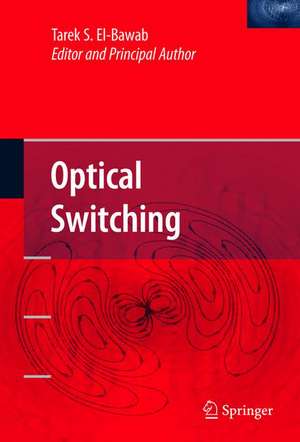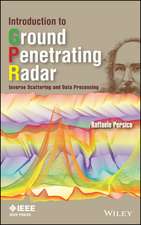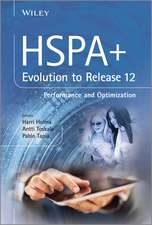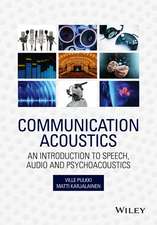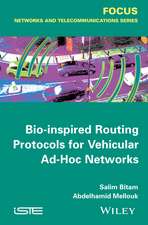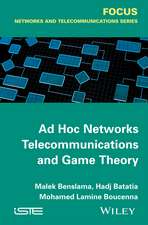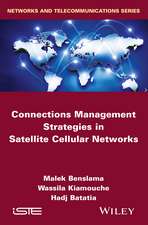Optical Switching
Autor Tarek S. El-Bawaben Limba Engleză Hardback – 4 apr 2006
| Toate formatele și edițiile | Preț | Express |
|---|---|---|
| Paperback (1) | 953.03 lei 6-8 săpt. | |
| Springer Us – 28 oct 2010 | 953.03 lei 6-8 săpt. | |
| Hardback (1) | 962.35 lei 6-8 săpt. | |
| Springer Us – 4 apr 2006 | 962.35 lei 6-8 săpt. |
Preț: 962.35 lei
Preț vechi: 1173.60 lei
-18% Nou
Puncte Express: 1444
Preț estimativ în valută:
184.17€ • 191.57$ • 152.04£
184.17€ • 191.57$ • 152.04£
Carte tipărită la comandă
Livrare economică 14-28 aprilie
Preluare comenzi: 021 569.72.76
Specificații
ISBN-13: 9780387261416
ISBN-10: 0387261419
Pagini: 451
Ilustrații: XXII, 452 p.
Dimensiuni: 155 x 235 x 30 mm
Greutate: 0.93 kg
Ediția:2006
Editura: Springer Us
Colecția Springer
Locul publicării:New York, NY, United States
ISBN-10: 0387261419
Pagini: 451
Ilustrații: XXII, 452 p.
Dimensiuni: 155 x 235 x 30 mm
Greutate: 0.93 kg
Ediția:2006
Editura: Springer Us
Colecția Springer
Locul publicării:New York, NY, United States
Public țintă
ResearchDescriere
Optical Switching is the most comprehensive and up to date reference book on its subject. After three decades of research and development efforts, optical switching has started to be deployed in cutting-edge networking initiatives. The optical devices, optical networks, and telecommunications/data networking communities are in need of a reference book that compiles diverse optical switching research, from device technologies to system and network architectures, into one properly structured volume. This book provides such a service to these communities.
The book is structured into three parts. The first part provides the foundation for understanding the potential role of optical switching in communication networks. The second part is focused on optical switching technologies and on devices based upon them. Theories, operation principles, and fabrication techniques are discussed. The third part covers optical-switching fabrics, systems, and networks. Applications of optical switching in communication networks are discussed, involving optical circuit, packet, and burst switching.
The chapters are self-contained with minimum overlap. They bring together academic and industrial contributions, analytical and descriptive treatments, and cover theories, experimentation, and practice. The material has been carefully coordinated to form a homogeneous manuscript having a progressive and logical development of ideas and concepts. The book embraces a number of distinctive innovations. Old and new terminologies are investigated, clarified, redefined where necessary, and used consistently throughout the entire volume. The treatment of the subject is original, not only in terms of comprehensive coverage, but also in terms of structure and organization.
The book is structured into three parts. The first part provides the foundation for understanding the potential role of optical switching in communication networks. The second part is focused on optical switching technologies and on devices based upon them. Theories, operation principles, and fabrication techniques are discussed. The third part covers optical-switching fabrics, systems, and networks. Applications of optical switching in communication networks are discussed, involving optical circuit, packet, and burst switching.
The chapters are self-contained with minimum overlap. They bring together academic and industrial contributions, analytical and descriptive treatments, and cover theories, experimentation, and practice. The material has been carefully coordinated to form a homogeneous manuscript having a progressive and logical development of ideas and concepts. The book embraces a number of distinctive innovations. Old and new terminologies are investigated, clarified, redefined where necessary, and used consistently throughout the entire volume. The treatment of the subject is original, not only in terms of comprehensive coverage, but also in terms of structure and organization.
Cuprins
Preliminaries and Terminologies.- Optical Switching Technologies.- Lithium Niobate Electro-Optic Switching.- Acousto-Optic Switching.- Thermo-Optic Switching.- Liquid-Crystal Based Optical Switching.- MEMS Based Optical Switching.- Optical Switching with SOAs.- Other Optical Switching Technologies.- Optical Switching Fabrics, Systems, and Networks.- Planar Optical Space Switch Architectures.- Switch Fabric Control.- Optical Switching in Communications Networks.- Protection and Restoration Architectures.- Optical Packet Switching and Optical Burst Switching.- Closing Remarks.
Notă biografică
Tarek S. El-Bawab, PhD, FIEEE was most recently the Dean of the School of Engineering and Professor of Electrical and Computer Engineering at the American University of Nigeria (AUN). Before this, he was Professor and Dean of Engineering and Applied Sciences at Nile University (Egypt), Professor of Electrical and Computer Engineering at Jackson State University (USA), and Project Manager with the Network Strategy Group (CTO organization) of Alcatel-Lucent USA (now Nokia). Before these positions, he assumed leading research roles with a number of organizations including: Alcatel (Alcatel-Lucent, now Nokia), the Department of Electrical and Computer Engineering at Colorado State University (USA), and the Department of Electronic Systems Engineering at University of Essex (UK). Earlier, he had led large-scale international telecommunication projects in the Middle East and Africa.
Dr. El-Bawab research interests include telecommunications, network architectures, optical networks, wireless networks, performance analysis, and Discipline Based Education Research (DBER). He has more than 80 scholarly journal/conference papers and patents. His book Optical Switching is one of the most comprehensive references in its subject. He is an IEEE Fellow, Series Editor of Springer’s Textbooks in Telecommunication and Network Engineering, the Editor in Chief of the IEEE Communications Magazine (2017-2021), member of Eta Kappa Nu (HKN), IEEE Distinguished Lecturer (2016-2019), and served as NSF Review Panelist.
Tarek led the Telecommunication Engineering Education (TEE) initiative and movement (2008-2014), which resulted in recognition of network/telecommunication engineering as distinct ABET-accreditable education discipline on November 1, 2014. He is the first recipient of the IEEE Communications Society’s (ComSoc) Education Award for this work (2015). The citation of this award reads: “for outstanding contributions to the definition, and to the accreditation criteria, of modern communication/telecommunication engineering education; and for making changes to our education system that benefit our community, society, and the profession.”He has served IEEE and the IEEE Communications Society (ComSoc) in numerous capacities: as Board Member of the IEEE Educational Activities Board (2016-2017), as Board Member of the IEEE PSPB Thesaurus Editorial Board (2021-2023), as Board Member of the ComSoc Board of Governors (2014-2015, 2018-2019, and 2020-2021), and Board Member of the ComSoc Educational Services Board (2012-2019). He served as the ComSoc Director of Industry Communities (2020-2021), Director for Standards Development (2018-2019) and Director of Conference Operations (2014-2015). He is a founding/active member of several ComSoc technical committees, and was elected Chair of the Transmission, Access, and Optical Systems (TAOS) Technical Committee for two terms. Tarek has served as symposium chair, workshops Chair, and organizer in several ICC/Globecom Conferences, and organized/chaired the ICC/Globecom International Workshop on Optical Networking Technologies (IWONT) for 10 years. He is also member of the IEEE Computer, Electron Devices, Photonics, and Education Societies. Dr. El-Bawab has B.Sc. in electrical engineering and B.A. in history, both from Ain Shams University, Cairo, Egypt. He holds M.Sc. in solid state science from the American University in Cairo, and M.Sc. in telecommunications and information systems from the University of Essex, UK. He obtained his Ph.D. in electrical engineering from Colorado State University.
Dr. El-Bawab research interests include telecommunications, network architectures, optical networks, wireless networks, performance analysis, and Discipline Based Education Research (DBER). He has more than 80 scholarly journal/conference papers and patents. His book Optical Switching is one of the most comprehensive references in its subject. He is an IEEE Fellow, Series Editor of Springer’s Textbooks in Telecommunication and Network Engineering, the Editor in Chief of the IEEE Communications Magazine (2017-2021), member of Eta Kappa Nu (HKN), IEEE Distinguished Lecturer (2016-2019), and served as NSF Review Panelist.
Tarek led the Telecommunication Engineering Education (TEE) initiative and movement (2008-2014), which resulted in recognition of network/telecommunication engineering as distinct ABET-accreditable education discipline on November 1, 2014. He is the first recipient of the IEEE Communications Society’s (ComSoc) Education Award for this work (2015). The citation of this award reads: “for outstanding contributions to the definition, and to the accreditation criteria, of modern communication/telecommunication engineering education; and for making changes to our education system that benefit our community, society, and the profession.”He has served IEEE and the IEEE Communications Society (ComSoc) in numerous capacities: as Board Member of the IEEE Educational Activities Board (2016-2017), as Board Member of the IEEE PSPB Thesaurus Editorial Board (2021-2023), as Board Member of the ComSoc Board of Governors (2014-2015, 2018-2019, and 2020-2021), and Board Member of the ComSoc Educational Services Board (2012-2019). He served as the ComSoc Director of Industry Communities (2020-2021), Director for Standards Development (2018-2019) and Director of Conference Operations (2014-2015). He is a founding/active member of several ComSoc technical committees, and was elected Chair of the Transmission, Access, and Optical Systems (TAOS) Technical Committee for two terms. Tarek has served as symposium chair, workshops Chair, and organizer in several ICC/Globecom Conferences, and organized/chaired the ICC/Globecom International Workshop on Optical Networking Technologies (IWONT) for 10 years. He is also member of the IEEE Computer, Electron Devices, Photonics, and Education Societies. Dr. El-Bawab has B.Sc. in electrical engineering and B.A. in history, both from Ain Shams University, Cairo, Egypt. He holds M.Sc. in solid state science from the American University in Cairo, and M.Sc. in telecommunications and information systems from the University of Essex, UK. He obtained his Ph.D. in electrical engineering from Colorado State University.
Textul de pe ultima copertă
Optical Switching is the most comprehensive and up to date reference book on its subject. After three decades of research and development efforts, optical switching has started to be deployed in cutting-edge networking initiatives. The optical devices, optical networks, and telecommunications/data networking communities are in need of a reference book that compiles diverse optical switching research, from device technologies to system and network architectures, into one properly structured volume. This book provides such a service to these communities.
The book is structured into three parts. The first part provides the foundation for understanding the potential role of optical switching in communication networks. The second part is focused on optical switching technologies and on devices based upon them. Theories, operation principles, and fabrication techniques are discussed. The third part covers optical-switching fabrics, systems, and networks. Applications of optical switching in communication networks are discussed, involving optical circuit, packet, and burst switching.
The chapters are self-contained with minimum overlap. They bring together academic and industrial contributions, analytical and descriptive treatments, and cover theories, experimentation, and practice. The material has been carefully coordinated to form a homogeneous manuscript having a progressive and logical development of ideas and concepts. The book embraces a number of distinctive innovations. Old and new terminologies are investigated, clarified, redefined where necessary, and used consistently throughout the entire volume. The treatment of the subject is original, not only in terms of comprehensive coverage, but also in terms of structure and organization.
This is an essential reference for researchers, scientists, professional engineers, and students in the areas of optical technologies and devices, and communication systems and networks. It is also a valuable resource in its subject for many others in the fields of electrical, computer and optical engineering. Twenty-four authors contributed the fourteen chapters of this book, including the Editor Tarek S. El-Bawab who authored four chapters.
The book is structured into three parts. The first part provides the foundation for understanding the potential role of optical switching in communication networks. The second part is focused on optical switching technologies and on devices based upon them. Theories, operation principles, and fabrication techniques are discussed. The third part covers optical-switching fabrics, systems, and networks. Applications of optical switching in communication networks are discussed, involving optical circuit, packet, and burst switching.
The chapters are self-contained with minimum overlap. They bring together academic and industrial contributions, analytical and descriptive treatments, and cover theories, experimentation, and practice. The material has been carefully coordinated to form a homogeneous manuscript having a progressive and logical development of ideas and concepts. The book embraces a number of distinctive innovations. Old and new terminologies are investigated, clarified, redefined where necessary, and used consistently throughout the entire volume. The treatment of the subject is original, not only in terms of comprehensive coverage, but also in terms of structure and organization.
This is an essential reference for researchers, scientists, professional engineers, and students in the areas of optical technologies and devices, and communication systems and networks. It is also a valuable resource in its subject for many others in the fields of electrical, computer and optical engineering. Twenty-four authors contributed the fourteen chapters of this book, including the Editor Tarek S. El-Bawab who authored four chapters.
Caracteristici
* Tarek S. El-Bawab is the Editor and Principal Author of this book
Provides up-to-date comprehensive coverage of optical switching, technologies, devices, systems and networks
Discusses applications of optical switching in network elements and communications networks
Provides up-to-date comprehensive coverage of optical switching, technologies, devices, systems and networks
Discusses applications of optical switching in network elements and communications networks
